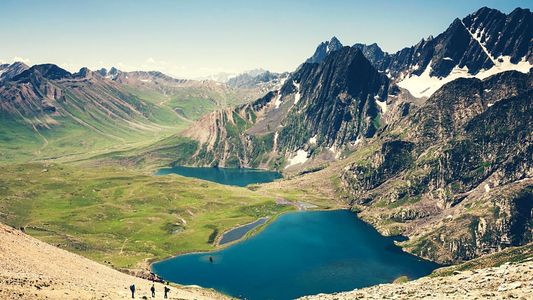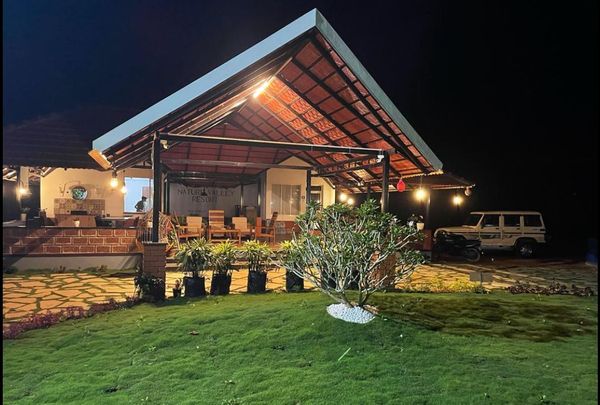The Crown Jewel of Himalayan Treks: Kashmir Great Lakes Explored
 Palakshi Meharwal
02 Jun, 2025
10 mins read
28
Palakshi Meharwal
02 Jun, 2025
10 mins read
28

Nestled in the northern reaches of India, the Kashmir Great Lakes Trek has earned a reputation as the crown jewel of Himalayan trekking. This journey offers a rare confluence of alpine meadows, glacial lakes, and rugged mountain trails, all under the expansive sky of one of the world’s most scenic regions. For trekkers seeking both natural beauty and a meaningful outdoor experience, this trek delivers beyond expectations.
A Glimpse into the Route
The Kashmir Great Lakes Trek typically spans 7 to 9 days, starting from the quaint village of Sonamarg and culminating in Naranag, both located within the Kashmir Valley. Throughout the journey, trekkers pass by a stunning series of high-altitude lakes including Vishansar, Gadsar, Satsar, Gangbal, and Nundkol. Each lake holds its own unique character, reflecting towering snow-dusted peaks and surrounded by sprawling meadows that bloom with wildflowers during the summer months.
The route stretches over 70 to 75 kilometers, reaching altitudes of 13,750 feet at the highest points. This moderate-to-difficult trek is suitable for individuals with reasonable fitness and some high-altitude hiking experience.
Why It’s Known as the “Crown Jewelâ€
What sets the Kashmir Great Lakes Trek apart from other Himalayan treks is its variety of landscapes and day-to-day visual drama. Unlike treks that follow a single scenic theme, this trail unfolds like a cinematic sequence. One moment you’re descending through pine forests, and the next you’re crossing rocky mountain passes with pristine lakes glinting below.
The transition between ecosystems—forests, grasslands, and alpine deserts—creates an ever-changing backdrop. This diversity makes it feel as though you’re experiencing multiple treks in one. Trekkers frequently cite the moments spent beside the twin lakes of Gangbal and Nundkol, with Mount Harmukh looming in the background, as among the most spiritually uplifting experiences of their journey.
Best Time to Visit
The ideal time to undertake the Kashmir Great Lakes trek is between July and early September. During this window, the snow has melted enough to open the mountain passes, and the valley is in full bloom. Wildflowers like blue poppies, buttercups, and forget-me-nots carpet the meadows, while the lakes remain accessible yet icy and crystal-clear.
Attempting the trek outside this period—particularly in June or October—can be dangerous due to unpredictable snow and landslides. Furthermore, many parts of the trail may be inaccessible or closed by local authorities for safety reasons.
Flora, Fauna, and Natural Richness
This region is not just a visual feast—it’s also an ecological treasure. The meadows along the trek support diverse plant species that are found only in the Western Himalayas. Birds like the Himalayan monal, lammergeier, and snow partridge can occasionally be spotted. In the higher reaches, trekkers might glimpse elusive mammals such as Himalayan marmots or ibex, though encounters are rare and usually fleeting.
The lakes themselves are glacial in origin and largely untouched by human activity, a rarity in today’s trekking circuits. Many locals regard them as sacred, and it’s important to respect their cultural and environmental significance.
Cultural and Historical Insights
While the trek is predominantly a natural experience, it’s intertwined with the region’s rich cultural tapestry. Several of the meadows are used by Gujjar and Bakarwal shepherds, semi-nomadic communities who migrate with their flocks during the summer months. Their presence adds a timeless, pastoral charm to the trek and offers a window into a lifestyle unchanged for generations.
Though you won’t pass through many villages, the start and end points—Sonamarg and Naranag—are steeped in history. Naranag, in particular, is known for its 8th-century temple ruins, believed to be associated with Shaivism. These vestiges are a compelling reminder of the valley’s ancient spiritual roots.
What to Pack and Prepare For
Proper preparation is essential to enjoy the trek safely. Here are a few essentials:
- Layered clothing for rapidly changing weather.
- A sleeping bag rated for sub-zero temperatures.
- High-ankle trekking boots with good grip.
- Water purification tablets or a filtration system.
- A lightweight backpack with rain cover.
- Personal first aid kit, including medications for altitude sickness.
Trekkers are also advised to spend a day or two acclimatizing in Srinagar or Sonamarg before beginning the trek. This helps mitigate the effects of altitude and ensures a smoother experience.
Trekking With Responsibility
The increasing popularity of this trek brings with it the risk of ecological degradation. Littering, trail erosion, and disruption to local wildlife are growing concerns. Trekkers are encouraged to follow Leave No Trace principles: carry back all waste, avoid using soap in lakes, and respect local customs.
Several local trekking operators now focus on eco-friendly and community-based tourism, hiring local guides and porters and contributing to village economies. Choosing such operators can make a significant difference in preserving the sanctity of the trek.
Accessibility and Permits
Travelers can reach the trek's starting point by flying into Srinagar, followed by a 3-hour drive to Sonamarg. Inner Line Permits are generally not required for Indian citizens, but foreigners should confirm with local authorities or their trek operator due to varying geopolitical regulations in Jammu & Kashmir.
Because the trek passes close to the Line of Control (LoC), security protocols can sometimes impact accessibility. It is wise to stay updated through verified local sources and consider booking through experienced trekking companies with a presence in the valley.
Final Thoughts
The Kashmir Great Lakes Trek is more than a hike; it's a passage through some of the most spellbinding terrain India has to offer. For those yearning for solitude, inspiration, and a taste of raw nature untouched by commercialization, this trail delivers in abundance.
But its future depends on how we choose to explore it. A respectful, informed, and sustainable approach ensures that this crown jewel of Himalayan treks continues to shine brightly for generations to come.
Written By:
Palakshi Meharwal



Hotels at your convenience
Now choose your stay according to your preference. From finding a place for your dream destination or a mere weekend getaway to business accommodations or brief stay, we have got you covered. Explore hotels as per your mood.


